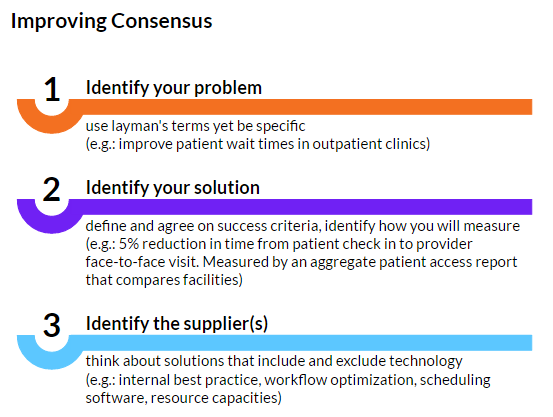Decision making is a task that some enjoy, but most find arduous. Maybe your the type of personality that constantly revisits decisions even after you’ve made them or maybe you pride yourself on making efficient, definitive decisions. With either method, it’s fair to say that speed and quality are always desired. Since the Valify Marketplace is a platform that helps healthcare organizations make better decisions, faster, this blog post explores the psychology of infusing decisions with quality and speed.
Step 1: Include the right [number of] people at the table
The Harvard Business Review did a study that found that, on average, 5.4 individuals were needed to sign off on major purchasing decisions. In the complexity of healthcare, the wisdom and subject areas of stakeholders go far beyond the c-suite.
Here are some things you can do today to increase the effectiveness of gathering consensus:

Step 2: Know your exit criteria
In the ever-changing startup world, technology companies understand the concept of failing fast well. To put it in decision making terms — what would automatically disqualify an option, regardless of how impressive it seems? The aim here is to quickly shortlist options so you can get to the real meat of suppliers and solution sets that will actually solve your problem. For the speediest human sorting machine, consider phrasing your exit criteria into yes/no questions. Here are typical examples (some are more obvious than others):
- Does this fall within my budget?
- Does this interface with my existing process? Does it need to?
- Is the service vendor easy to implement and onboard?
- Is there an in-house solution that could solve my problem?
- Has the market tested this service provider? Do I care?
It’s important to get your list of potential vendor options down to a reasonable amount so that comparisons are more manageable.
Step 3: Avoid analysis paralysis
Why is it so important to get your options down to a reasonable amount? What amount is reasonable?
Choice overload is a real thing.
In 2000, research found that too many choices make it harder to make a decision. AND once you finally do, you’re more likely to regret the decision you made. The Harvard Business Review replicated this study and found that “increased choice decreases satisfaction with matters as trivial as ice cream flavors and as significant as jobs.”
Attribute overload is also a real thing.
This same concept applies to attributes. Research states that consumers make decisions more quickly and with more resulting satisfaction when there is an attribute alignment and cognitive overload is lessened. For example, products arranged into Good, Better, Best (e.g.: computers, cars, cell phone data) streamlined decision making. A consumer shouldn’t have to waddle through competing attributes that muddle the decision-making process – do I want a sunroof or leather seats? Another strategy includes questionnaires or forms that guide buyers into a recommendation. This strategy lessens the regret factor. One example of this type of questionnaire you may be familiar with is one deployed by financial advisors when assessing their clients’ risk comfort level. This assessment aims to get the client and advisor on the same page when choosing a strategy and it sets expectations as much as possible – additionally, it can be referenced in order to ease anxieties when the market shifts.
The next post in this series, gets closer to defining the sweet spot, backed by science and how to know when you have too many cooks in the kitchen.

